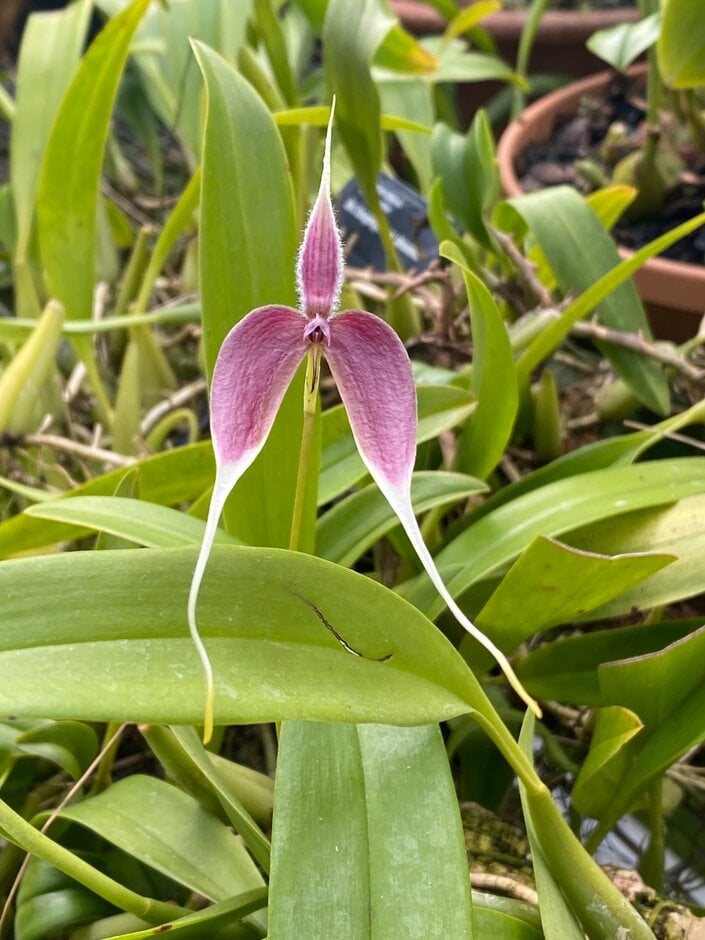Bulbophyllum maxillare
A fast-growing, branching orchid, with a creeping stem found growing on the bark of large, lower, tree branches. It prefers warm to hot growing conditions, partial shade and high humidity such as is found in wet, tropical lowland forests. It produces tapered green to yellowish swollen stems called pseudobulbs which store water and nutrients, each carrying a single oval to lance-shaped, leathery leaf at the tip. Flower stems to 15cm long are produced from spring to autumn, each carrying a single flower in reddish purple, yellow and white

Size
Ultimate height
0.1–0.5 metresTime to ultimate height
2–5 yearsUltimate spread
0.1–0.5 metresGrowing conditions
Moisture
Moist but well–drainedpH
NeutralColour & scent
| Stem | Flower | Foliage | Fruit | |
| Spring | Green | Red White Yellow | Green | |
|---|---|---|---|---|
| Summer | Green | Red White Yellow | Green | |
| Autumn | Green | Red White Yellow | Green | |
| Winter | Green | Green |
Position
- Partial shade
Aspect
East–facing or North–facing or West–facing
Exposure
Sheltered Hardiness
H1ABotanical details
- Family
- Orchidaceae
- Native to GB / Ireland
- No
- Foliage
- Evergreen
- Habit
- Clump forming, Spreading branched
- Genus
A large, diverse genus of mainly epiphytic, sympodial tropical orchids, producing a clump of small pseudobulbs, which serve as plant’s storage for water and nutrients. Most species carry one leaf on top of each pseudobulb. Over 2000 species have been described and accepted
- Name status
Correct
- Plant range
- Malaysia, Indonesia, New Guinea and North Queensland, Australia
How to grow
Cultivation
Grow in an open, well drained but moisture-retentive mix of medium orchid bark, sphagnum moss and perlite. Shallow, wide pots or baskets are best used to accommodate its spreading habit. Bright filtered light is best as direct sunlight through glass can scorch its leaves. Prefers a minimum night temperature of 15°C and a maximum of 30°C in the daytime. Nighttime temperatures should be 10°C lower than daytime temperatures for good growth and is beneficial to induce flowering. High humidity is required along with gentle air movement. Allow plants to freely drain when watering and avoid plants sitting in water as this can cause roots to rot. Plants may be intolerant of hard tap water, so irrigate with rainwater at room temperature. Orchid fertiliser can be applied regularly throughout the growing season, March to September. Reduce watering and feeding in winter months. See indoor orchid cultivation for further advice
Propagation
Propagation by seed is only possible in a controlled laboratory environment. Mature plants may be divided when the plant overgrows its container. Each division should have at least 3 older pseudobulbs with a sufficient amount of stored energy and water, to support new growth and reduce stress after repotting
Suggested planting locations and garden types
- Conservatory and greenhouse
Pruning
No pruning required. Remove spent flower stem at the base
Pests
May be susceptible to mealybugs and scale insects
Diseases
Generally disease-free
Get involved
The RHS is the UK’s gardening charity, helping people and plants to grow - nurturing a healthier, happier world, one person and one plant at a time.